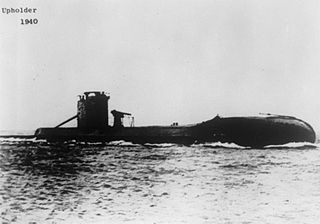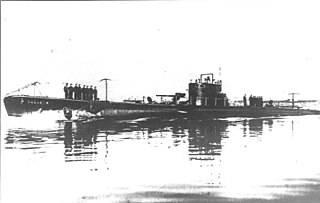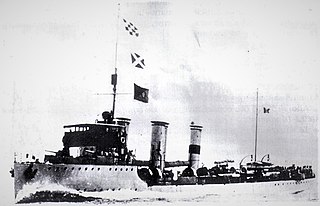
HMS Upholder (P37) was a Royal Navy U-class submarine built by Vickers-Armstrong at Barrow-in-Furness. She was laid down on 30 October 1939, launched on 8 July 1940 by Mrs. Doris Thompson, wife of a director of the builders. The submarine was commissioned on 31 October 1940. She was one of four U-class submarines which had two external torpedo tubes at the bows in addition to the 4 internal ones fitted to all boats. They were excluded from the others because they interfered with depth-keeping at periscope depth.

Lieutenant Commander Malcolm David Wanklyn, was a Royal Navy commander and one of the most successful submariners in the Western Allied navies during the Second World War. Wanklyn and his crew sank 16 enemy vessels.

HMS Safari was a third batch S-class submarine built for the Royal Navy during World War II. Commissioned in 1942, she was assigned to operate in the Mediterranean Sea. During the course of the war, Safari sank twenty-five ships, most of which were Italian.

The Battle of the Tarigo Convoy was a naval battle of the Second World War, part of the Battle of the Mediterranean. It was fought on 16 April 1941, between four Royal Navy destroyers and three Italian destroyers of the Regia Marina which were escorting a convoy near the Kerkennah Islands off Sfax, on the Tunisian coast.

The Battle of the Duisburg Convoy was fought on the night of 8/9 November 1941 between an Italian convoy, its escorts and four British ships. The convoy was named BETA by the Italian naval authorities and carried supplies for the Italian Army civilian colonists and the Afrika Korps in Italian Libya.
HMS P32 was a Royal Navy U-class submarine built by Vickers-Armstrong at Barrow-in-Furness.

SS Conte Rosso was an Italian transatlantic ocean liner that was built in Scotland in 1921–22. The vessel became a troop ship in the 1930s and was sunk by the submarine HMS Upholder in 1941.

HMS Regent was a Rainbow-class submarine designed and built by Vickers Shipbuilding and Engineering in Barrow-in-Furness for the Royal Navy, and was launched on 11 June 1930. She was lost with all hands after striking a mine on 18 April 1943.

Aviere ("Airman") was one of seventeen Soldati-class destroyers, built for the Regia Marina in the late 1930s and early 1940s.

Ascari was one of nineteen Soldati-class destroyers built for the Regia Marina in the late 1930s and early 1940s. Completed in mid-1939, she was the last of the first batch of a dozen ships to enter service.

Italian submarine Dagabur was an Adua-class submarine built for the Royal Italian Navy during the 1930s. It was named after the town of Dagabur in eastern Ethiopia. The submarine played a minor role in the Spanish Civil War of 1936–1939, supporting the Spanish Nationalists. On August 11, 1942, during World War II, Dagabur was rammed by destroyer HMS Wolverine and sank with all hands.
Guglielmotti was a Brin-class submarine built for the Royal Italian Navy during the 1930s.

Captain Michael Lindsay Coulton "Tubby" Crawford DSC & Bar was an officer in the Royal Navy and submariner.

Turbine was the lead ship of her class of eight destroyers built for the Regia Marina during the 1920s. Her name means whirlwind.

Pegaso was a torpedo boat and an escort aviso of the Italian Regia Marina. She was one of the most successful Axis anti-submarine warships of World War II.

Giuseppe Missori was an Italian Rosolino Pilo-class destroyer. Commissioned into service in the Italian Regia Marina in 1916, she served in World War I, playing an active role in the Adriatic campaign. Reclassified as a torpedo boat in 1929, she participated in the Mediterranean campaign and Adriatic campaign of World War II until the Italian armistice with the Allies, prompting Nazi Germany to capture her. Subsequently operating in the Kriegsmarine as TA22, she participated in the Adriatic campaign until she was seriously damaged in 1944. She sank in May 1945.
Giuseppe La Farina was an Italian La Masa-class destroyer. Commissioned into service in the Italian Regia Marina in 1919, she participated in operations related to the Corfu incident in 1923. Reclassified as a torpedo boat in 1929, she took part in the Mediterranean campaign of World War II until she was sunk in 1941.

Pilade Bronzetti was an Italian Rosolino Pilo-class destroyer. Commissioned into service in the Italian Regia Marina in 1916, she served in World War I, participating in the Adriatic campaign. Her crew supported Gabriele D'Annunzio′s actions in Fiume in 1920, and as a consequence she was renamed Giuseppe Dezza in 1921. Reclassified as a torpedo boat in 1929, she took part in the Mediterranean campaign of World War II until the Italian armistice with the Allies, prompting Nazi Germany to capture her. Subsequently operating in the Kriegsmarine as TA35, she participated in the Adriatic Campaign of World War II until she was sunk in 1944.
The MS Neptunia was an Italian ocean liner built by Cantiere Navale Triestino, Trieste for the Cosulich Line. She was launched on 27 December 1931 and on 5 October 1932, she left Trieste on her maiden voyage to Buenos Aires. During 1935 the ship began operating on the Bombay to Shanghai route. During 1937 the Cosulich Line was amalgamated into the Italian Line.
Barletta was an Italian cargo liner built during the 1930s and later became an auxiliary cruiser of the Regia Marina during World War II.















